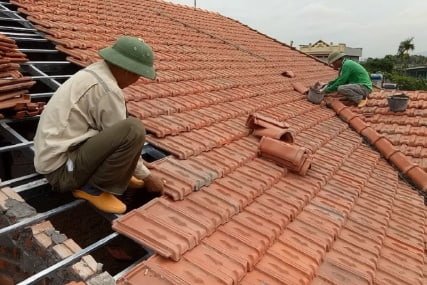Table of Contents
Clay roof tiles are prepared by baking molded clay. The density of clay roofing tiles is known by how long the tiles are heated, and at what temperature. Roofing tiles can vary in color, available in shades of white, yellow, orange, and even brown. However, the major color of clay tile available in the market is Terra-cotta.
It is essential that clay roof tiles may also be termed Spanish tile roofs in locations like Latin America and Spain. The peak temperatures utilized to bake clay tiles help bond the color so it will never peel or fade away. They are a very durable roofing choice and highly insulating.
1. Manufacturing of Clay Tiles
Clay roof tiles are prepared to utilize the same process as bricks. But tiles are thinner and lighter. The clay utilized for the preparation of roof tiles should be highly plastic.
Clay tiles are prepared from clays burning at a temperature of 1300º C after molding into the needed shape, and size. In this burning process. coloring admixtures are also utilized. This burning process is done in kilns.

2. Characteristics of Clay Roof Tiles
The characteristics of clay roof tiles are as follows:
a. Clay tiles have a low water absorption rate.
b. Clay tiles are more lightweight than concrete tiles, clay only weighs about 600 to 650 pounds.
c. Clay tiles have a higher chance to crack or shatter when opened to either freezing or thawing temperatures.
d. It needs less maintenance.
e. Clay is naturally available, clay tiles can hold their original color for many years.
f. It is more long-lasting, with the ability to last well over 100 years.
g. Clay tiles can price up to $700 to $1,000 per 100 square feet, with maximum clay tiles costing as much as $3,000.

3. Qualities of Roofing Tiles
The qualities of roofing tiles are as follows:
a. Free from cracks and flaws
b. The size and shape should be accurate
c. They should have a uniform texture.
d. It should have high durability
e. The water absorption should be less than 15 percent.
4. Uses of Clay Roof Tiles
The uses of clay roof tiles are as follows:
a. They are utilized for small building projects of low cost.
b. They are utilized to enhance the aesthetic beauty of a building.
c. They are majorly utilized for buddha temples in China and Nepal.
d. Clay tiles are major attractions of that temples.
5. Prices of Clay Roof Tiles
The cost for clay tiles (excluding installation costs) is about $50 – $100 per square.
Where,
1 square = 100 square feet.
8. Designs of Clay Tiles



7. Advantages of Clay Roof Tiles
The advantages of clay tiles are as follows:
1. Long Life Span
Clay roof tiles have a longer lifespan than that other types of materials. These roofs can do their work for as long as a hundred years.
2. Low Maintenance
If we compare to concrete tiles, clay tiles need low maintenance, which can lower the total cost of ownership.
3. Durability
The clay tiles do not rot and can withstand fire and are insect-resistant.
4. Insulation
Air freely moves below these tiles, which run rooftop temperatures, used to balance temperatures inside the building.
5. Weather resistance
Many materials expand and contract to a higher degree when the utmost conditions arise. In contrast, clay keeps the roof’s integrity by resisting the maximum hot and cold weather periods. They are also able to withstand the dangerous ultra-violet radiation from the sun.
6. Aesthetics
The style of clay tile roofs is motivated by Spanish and Mediterranean designs. This aspect adds a variety of sidings. For example, a clay tile roof can increase the beauty of brick or stone sidings, preparing it compatible with the most trending design styles for buildings.
8. Disadvantages of Clay Roof Tiles
The disadvantages of clay tiles are as follows:
1. Technical manpower is needed.
2. It can be broken easily into pieces.
3. Not suitable for all roof slopes
4. The cost of clay tiles is expensive.
| Read Also: Tiles |

